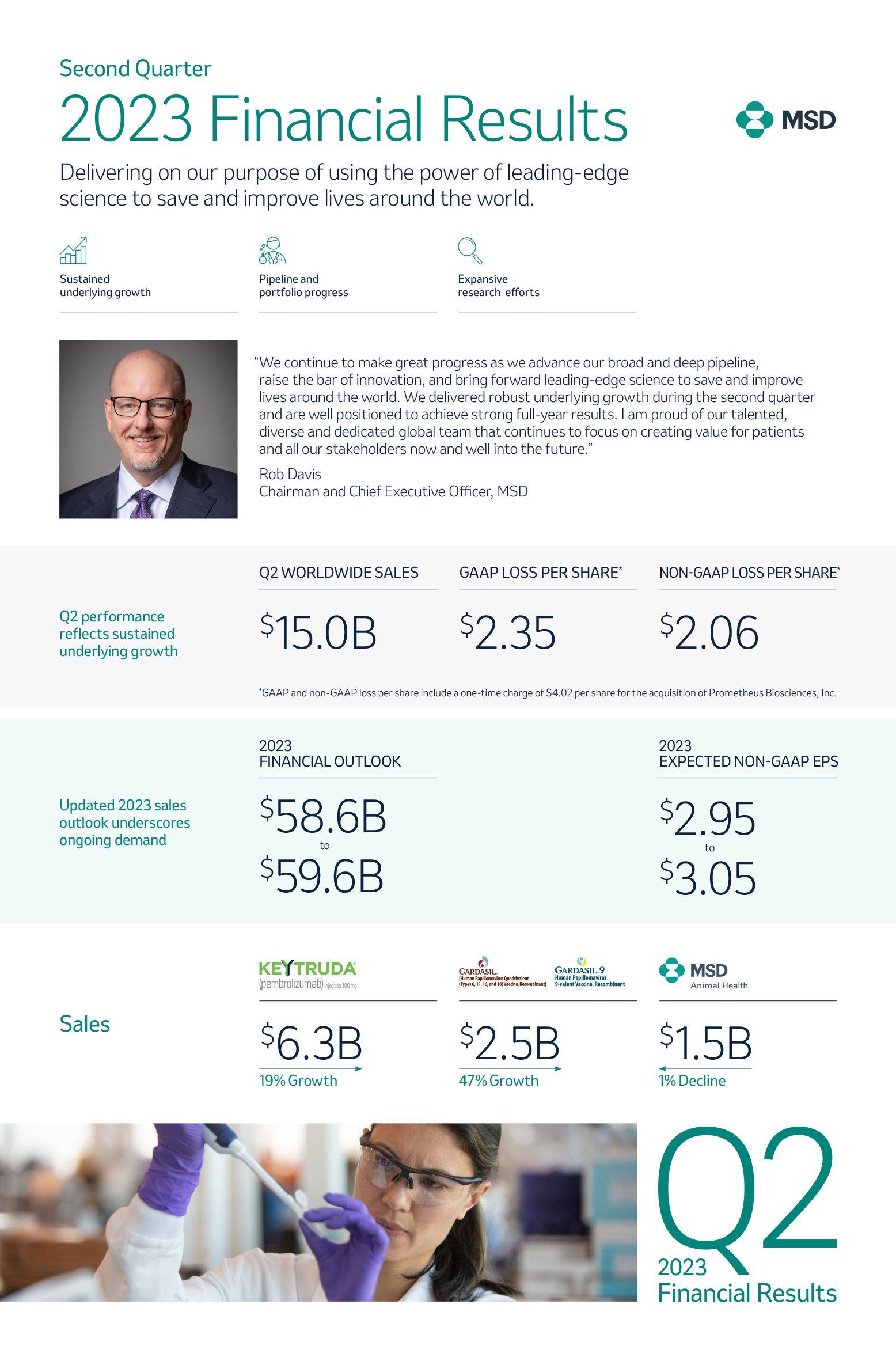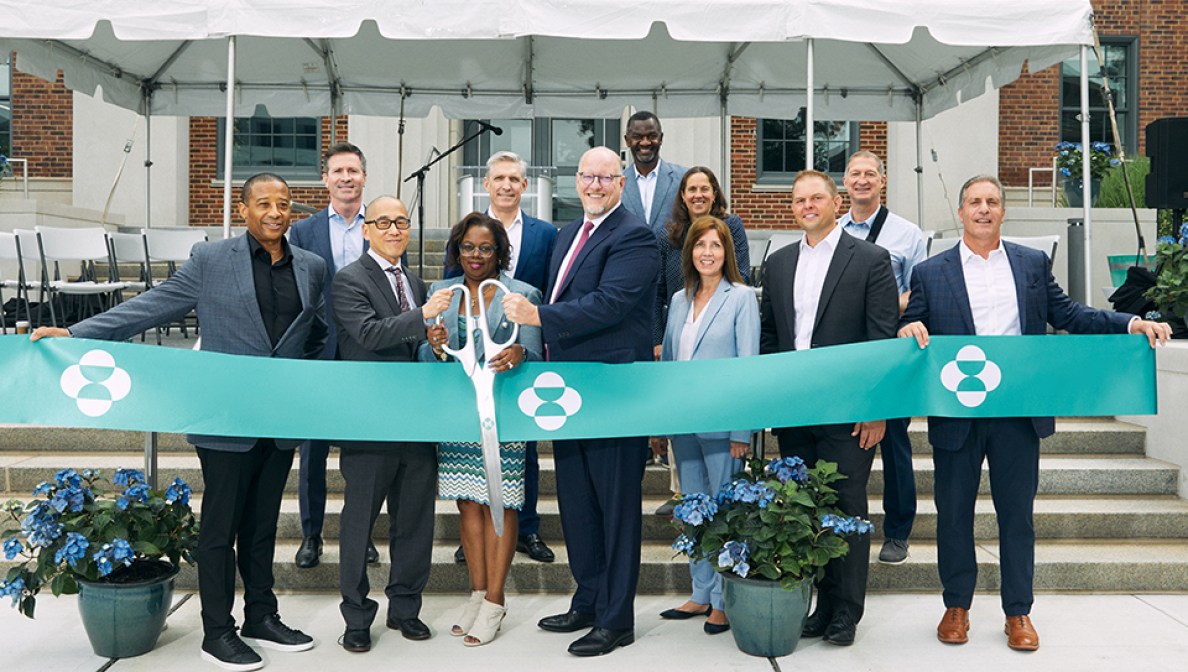MSD publishes Impact Report 2022/2023
Letter from our chairman and chief executive officer, Rob Davis
August 9, 2023

Dear Stakeholders,
Thank you for your interest in MSD and our ongoing commitment to operating responsibly and creating value for patients, our stakeholders and our business. We continue to take inspiration from our purpose and our unique opportunity to use the power of leading-edge science to save and improve lives around the world.
Sustainable value creation is core to how we do business as we work to advance global health, apply innovative science and ultimately protect and improve the health of people and animals through the development and delivery of medicines, vaccines and technology solutions. We’re passionate about this work and committed to making a positive difference for patients and the world while driving strong business outcomes. Working globally as One Team, we organize our sustainability efforts across four focus areas to create long-term value: 1) expanding access to health; 2) developing and rewarding a diverse, inclusive and healthy workforce; 3) protecting the environment; and 4) operating with the highest standards of ethics and values.
Expanding access to health
Two years ago, we set a goal to enable 100 million more people to access our innovative portfolio globally, through access strategies, solutions and partnerships, by 2025. We exceeded this goal already in 2022. As a result, we increased our ambition and more than tripled our original goal. We now aim to enable 350 million more people to access our innovative portfolio by 2025.
We’re eager to reach more people not only now, but in the years to come. To this end, we pursued new scientific discoveries with an investment last year of $13.5 billion in research and development. In total, our products and pipeline seek to address 83% of the top 20 global burdens of diseases.
In 2022, our MECTIZAN® Donation Program turned 35 years old. The longest-running disease-specific drug donation program of its kind, this successful effort to combat river blindness and lymphatic filariasis reached nearly 360 million people last year1. We also invested $38 million to advance health equity through initiatives like MSD for Mothers. These investments support our goal to reach over 30 million people in low- and middle-income countries (LMICs) and in U.S. underserved populations with our social investments, by 2025. We surpassed this goal as well in 2022. Our new goal is to reach over 50 million people in LMICs, underserved populations in the U.S. and, going forward, underserved populations in other high-income countries, by 2025.
Developing and rewarding a diverse, inclusive and healthy workforce
We’re committed to investing in our colleagues and building a strong pipeline of talent as an employer of choice. Across our organization, we value diversity and inclusion as both an ethical and business priority.
We’re becoming even more inclusive in our hiring, working with organizations including OneTen, a business coalition striving to close the opportunity gap for Black workers without four-year college degrees. In order to create more access to meaningful career opportunities for diverse candidates, we posted about 900 job openings not requiring a four-year degree, which was twice as many as the previous year. In addition, in 2022 we hosted 90 student interns through Year Up, a nonprofit serving economically disadvantaged young people. Women represented more than half of our new hires globally, and in the U.S., 47% of new hires came from underrepresented ethnic groups.
We have a longstanding commitment to fair and equitable pay for all employees doing similar work. In the U.S., our 2022 study found that we had achieved greater than 99% pay equity for female and male employees, as well as non-white (including Black, Hispanic and Asian employees) and white employees. Our commitment to diversity and inclusion also extends to our business partners. Last year, we spent $3.2 billion with diverse Tier 1 and 2 suppliers globally.
Protecting the environment
Our company has a long history of environmental stewardship, and we believe a healthy planet is essential to improving health and protecting the sustainability of our business. As part of this work, we have committed to the Science Based Targets initiative (SBTi) to set a net-zero target for our greenhouse gas (GHG) emissions across our global operations (Scopes 1, 2, 3).
We know that each of our research, production and office facilities plays a role in achieving our goals for energy efficiency, waste reduction and overall sustainability. In 2022, we created a Waste Diversion Playbook to help sites contribute to our goals through local waste-diversion strategies, such as composting and recycling, and environmentally responsible procurement practices.
Operating with the highest standards of ethics and values
We operate responsibly every day, holding ourselves to the highest standards of ethics and values. Our code of conduct defines our corporate character and helps us protect our reputation as a trustworthy company. We maintain 100% compliance to regulatory requirements for active incident monitoring, risk and harm analysis, and timely notification of data breaches. We also encourage employees to speak up and report potential concerns, ensuring our ethics and values are reflected in all we do.
As a signatory to the United Nations Global Compact (UNGC), MSD remains committed to improving our communities through our operations, aligning our efforts with the Ten Principles of the UNGC.
In late 2021, we announced the issuance of our first $1 billion sustainability bond to support initiatives and partnerships contributing to the advancement of the United Nations Sustainable Development Goals. Through June 2022, we allocated $760 million of the net proceeds toward social and green projects, in alignment with our sustainability financing framework.
While my colleagues and I are pleased by our 2022 progress, we remain committed to doing more to advance and protect the health of our employees, communities and planet. Indeed, I want to thank our colleagues and partners for the passion and expertise brought to this work every day. I’m honored to work alongside such a talented and dedicated team.
Thank you again for your interest in our company’s progress and performance. We’re excited for our future — and the unique opportunity we have to make a difference through our research, our medicines and vaccines, and our enduring commitment to sustainable innovation and value creation.
Very best regards,
Rob Davis
Chairman & Chief Executive Officer
1 Countries receiving donated Mectizan are located in Africa, Asia, the Middle East, South America, and the Western Pacific






















